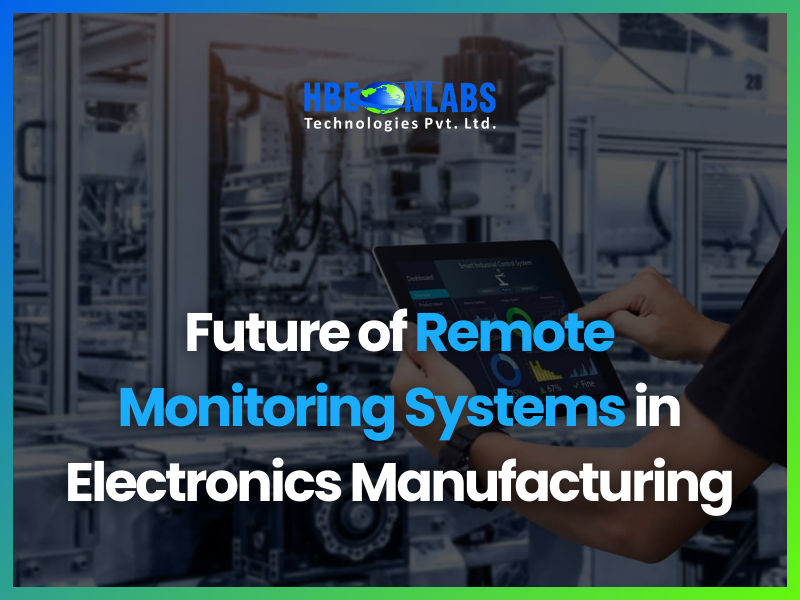Address:
Plot No. B-6/5, Site 5 Surajpur Industrial Area, Block F, Surajpur Site V, Greater Noida, Uttar Pradesh 201306
For Business: +91 9212314779
For Careers: +91 84483 40400
Landline: 0120-4298000


The introduction of remote monitoring devices has caused a significant revolution in the electronics manufacturing industry. These systems, which use the Internet of Things (IoT) and other modern technologies, are transforming how manufacturers monitor, control, and improve their operations. This blog covers the future of remote monitoring systems in electronics production, focusing on their advantages, uses, and the technical innovations powering this transformation.
Benefits of Remote Monitoring Systems
Remote monitoring systems enable real-time monitoring of manufacturing processes, helping identify and address inefficiencies promptly. This leads to reduced downtime and increased productivity. According to a report by McKinsey, IoT applications in operations could generate up to $1.8 trillion in economic value annually by 2025.
With real-time data collection and analysis, remote monitoring systems help maintain consistent quality standards. Issues can be detected and rectified immediately, ensuring higher product quality and reducing waste.
Predictive maintenance uses data from remote monitoring systems to predict equipment failures before they occur. This proactive approach can significantly reduce maintenance costs and prevent unexpected downtime. A study by Deloitte highlights that predictive maintenance can reduce maintenance costs by 25% and breakdowns by 70%.
The data collected from remote monitoring systems provides valuable insights into the manufacturing process. This data-driven approach enables better decision-making, helping manufacturers optimize their operations and improve efficiency.
Applications of Remote Monitoring Systems
Remote monitoring systems provide real-time visibility into the manufacturing process, allowing for immediate response to any issues. This is crucial in maintaining high standards of quality and efficiency.
By integrating remote monitoring systems with supply chain management, manufacturers can track the movement of raw materials and finished products in real-time. This leads to better inventory management and reduces the risk of stockouts or overstocking.
Remote monitoring systems can help manufacturers monitor and optimize their energy usage, leading to significant cost savings. According to the International Energy Agency, optimizing energy use in manufacturing can reduce global energy consumption by up to 10%.
Technological Advancements Driving Remote Monitoring Systems
The integration of IoT technology with remote monitoring systems has been a game-changer for the electronics manufacturing services industry. IoT devices collect vast amounts of data, which can be analyzed to improve the manufacturing process. Companies like Bosch and GE are leading the way in developing IoT solutions for manufacturing.
The use of advanced analytics and artificial intelligence (AI) in remote monitoring systems enables manufacturers to predict and address issues before they occur. This technology also helps in optimizing the manufacturing process, leading to increased efficiency and reduced costs.
Cloud computing provides the necessary infrastructure for remote monitoring systems to collect, store, and analyze data in real-time. This technology ensures that manufacturers have access to the data they need, whenever they need it.
Edge computing allows data to be processed closer to the source, reducing latency and improving response times. This is particularly important in manufacturing, where real-time data processing is crucial for maintaining efficiency and quality.
Future Trends and Predictions
As the benefits of IoT remote monitoring solutions become more apparent, their adoption in the electronics manufacturing services industry is expected to increase. According to Gartner, manufacturing will use many of the 25 billion connected devices by 2025.
The integration of remote monitoring systems with other technologies, such as blockchain and 5G, will further enhance their capabilities. Blockchain can provide secure and transparent tracking of products, while 5G will enable faster and more reliable data transmission.
Remote monitoring systems will play a crucial role in helping manufacturers achieve their sustainability goals. By optimizing energy use and reducing waste, these systems can significantly reduce the environmental impact of manufacturing processes.
Future remote monitoring systems will be more customizable and scalable, allowing manufacturers to tailor them to their specific needs. This flexibility will make it easier for manufacturers of all sizes to implement these systems and reap their benefits.
Remote monitoring systems in electronics production have a promising future, thanks to substantial improvements in IoT, AI, and other technologies. These systems have several benefits, such as increased efficiency, greater quality control, predictive maintenance, and better decision-making. As more organizations welcome these technologies, the sector will grow more efficient, sustainable, and profitable.
HbeonLabs incorporate the latest developments in remote monitoring systems, allowing manufacturers to stay ahead of trends and improve their operations for the future.